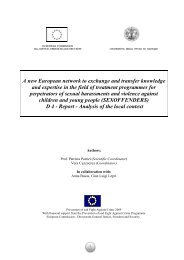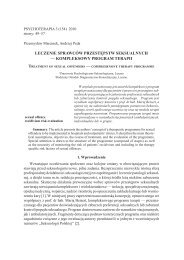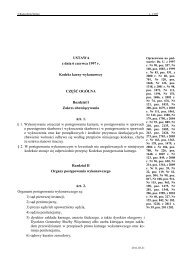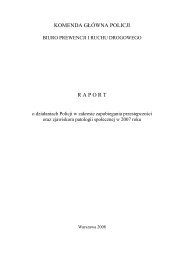of the violence. We ask if the victim sought help from institutions, were there witnesses, other people of agencies involved, inorder to complete our information with theirs.’What is quite interesting is that all 3 respondents who used either Big 26, DA or SARA never used just one tool in theiragencies, but at least two of those mentioned. This is due to the different experts they work with; the choice of method is upto the psychologist, not to the organisation, which would hardly apply 2 or more methods together.In all responding organisations, the women experiencing violence were involved in the assessment. The risk assessment iseffected by the case worker (all) and additionally in a multidisciplinary team (3 out of 7). With one exception (Child ProtectionAuthority) risk assessment is done systematically. The Child Protection Authority does not use an instrument in cases of sexualviolence and when they don’t have the consent of the woman.As to the question in how many cases an assessment tool was applied, the numbers vary greatly, and in many cases theyare the same as in Table 1 (see above).Table 2: In how many cases did you apply a risk assessment tool?Police regional –Women’sSupportServicesInterventionCentresregional 59regional 300regional –regional31ChildProtectionAuthoritiesregionalregionalNetwork (national)regional11923363All participants stated that they found it helpful to use a risk assessment tool. It is significant to see in what way such a tool isregarded as helpful: 6 out of 8 participants stated that the tool helps to identify high risk, and all said it is helpful in the senseof avoiding further violence. One pointed out that she finds it very helpful because the risk assessment is done by the clientherself together with an expert. One criticism was also voiced:’It is not helpful, because it takes too much time, the results do not coincide with my personal evaluations and because notall colleagues can apply it’.Safety planningAll Bulgarian respondents stated that their organisation/agency has standards for protection of high risk victims of intimatepartner violence and that they are available as written policies/guidelines. Taking a closer look at the answers, it turns out thatthe understanding of policy/guideline is actually the existing law and not a special guideline the respective organisation hasdeveloped for itself. The Women’s Support Services are an exception here: ’We have such standards and we apply themcase by case depending on the facts of the case and with the consent of the victim.’P 29
Research ReportsEight out of 9 offer safety planning, and the same number use a multi-agency approach. Here again, it is not clear what theparticipants mean by multi-agency approach. It can be assumed to mostly mean that an organisation/administrative body isprovided with information, but that an exchange on the work level as such does not take place.When asked how these standards are communicated to the staff, the answers vary from: ’Yes, we have written guidelineswhich are revised periodically, and they are distributed among the staff members involved in direct work with the victims(but not all staff members, e.g. part of the administrative staff is not included).’to ’The Head of the Department presents theguidelines to the staff at regular meetings.’All respondents said that their staff has regular training in working with high risk victims of intimate partner violence. 5 With theexception of the child protection unit all organisations offer training on working with high risk victims to newcomers. 6And the last question of this part, asking whether cases of homicides, attempted homicides and severe violence are regularlyreviewed and analysed within the agency, was answered with ’yes’ by all interviewed persons except for the respondent of thepolice, who stated that this is done, but on the next higher organisational level.Cooperation with other agenciesThis last part of the questionnaire was answered by 8 respondents. The police unit’s reason for not participating in this part isexplained by the interviewer:’This part of the questionnaire is not answered by the police unit, because of the above mentioned understanding of the riskassessment and the lack of data based on the risk for the victim assessment. The legal framework is binding the police toreport the information received to the prosecutor - so, this is the only institution with which they DO SHARE INFORMATION,for sure. The problem is that they don’t have criteria for high risk victims in their statistical database. Concerning the sharing ofinformation on high risk victims usually the information is provided to the police, rather than required from the police.’ 7The concept of cooperation seems to be viewed solely as an exchange of information by all responding parties. The resultsof the question regarding the basis of working together show a different picture.All respondents worked together in case conferences and all shared written reports. 50% also stated telephone conferencesas a form of cooperation. One intervention centre mentioned an additional other form of cooperation:’… at the training seminars, conferences, etc. with the participation of the representatives from the other institutions andorganisations we present more cases and data about the high risk victims of violence in order to discuss the implementationof the legislation and to define the gaps in it.’All 7 respondents stated that they need to have the woman’s consent to cooperate with other agencies: 3 needed at least averbal consent, 4 need the consent in writing.Access to the documentation is limited to the case worker in 5 out of 7 organisations, in one case it is available for all relevantunits of the organisation and in one case to both (case worker and unit).All 7 participants stated that they systematically share information on high risk cases within their own agency.5Here the question comes up, if the interviewers stressed the point specifically asking for training on high risk in the field of domestic violence.6See previous comment.7Interviewer’s noteP 30 | PROTECT | Good practice in preventing serious violence, attempted homicides, including crimes in the name of honour, and in protecting high risk victims of gender based violence






